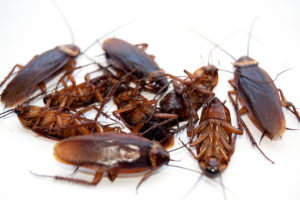 The German cockroach is by far the most important and usually the most common of the cockroaches. In addition to being a nuisance, it has been implicated in outbreaks of illness, the transmission of a variety of pathogenic organisms including at least one parasitic protozoan, and allergic reactions in many people. This species has worldwide distribution.
The German cockroach is by far the most important and usually the most common of the cockroaches. In addition to being a nuisance, it has been implicated in outbreaks of illness, the transmission of a variety of pathogenic organisms including at least one parasitic protozoan, and allergic reactions in many people. This species has worldwide distribution.
RECOGNITION. Adults about 1/2-5/8″ (13-16 mm) long. Color light brown to tan except for 2 dark, almost parallel longitudinal stripes/bars/streaks on pronotal shield.
The female carries her egg sack until it is within 1-2 days of hatching, and then deposits it in a sheltered area/site. On the average, the female will produce about 5 oothecae (range 4-8), averaging 30-40 eggs (range 18-50) each.
German cockroaches are found throughout structures but show a preference for warm (70°F/21°C) and humid places. They are usually found in kitchens and secondarily in bathrooms, but infestations often- occur in rooms where people eat and drink while watching television such as the den, bedroom, etc. Any crack or crevice located near a source of food and/or water is prime harborage, and they spend about 75% of their time in such harborages. First instar nymphs require a crack of about 1/32″ (1 mm) whereas, adults require a crack of about 3/16″ (5 mm) in width.
These cockroaches are most commonly introduced into buildings via paper products or paper packaging such as grocery bags, cardboard boxes, drink cartons, and via secondhand appliances such-as-refrigerators, televisions, VCR’s, microwaves, etc.
They have been observed to migrate from building to building on warm evenings, but this rarely occurs. Although uncommon, they can survive outdoors during the warm months. They feed on almost anything with nutritive value including all kinds of food, and such things as soap, glue, and toothpaste.
Follow the standard control procedures but more frequent service may be required because of their rapid reproductive rate. At least 95% of the population must be eliminated on the initial or clean-out service, or the typical maintenance program will usually fail. Baits are particularly effective, but correct placement along junctions and/or in cracks and crevices in or near harborages is essential. Incorporating IGRs (insect growth regulators) into the service helps with long-term control. Be sure to follow label directions.
